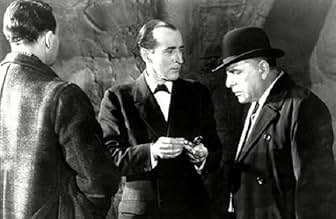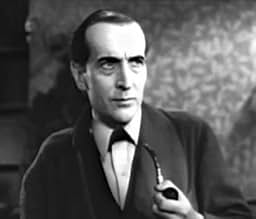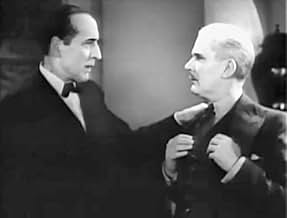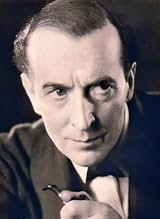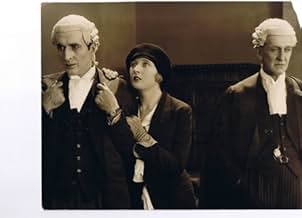Arthur Wontner(1875-1960)
- Actor
Arthur Wontner (1875-1960), the critics' choice. "No better "Sherlock
Holmes" than Arthur Wontner is likely to be seen and heard in pictures,
in our time... The keen, worn, kindly face and quiet prescient smile
are out of the very pages of the book",
Vincent Starrett's 'The Private Life of
Sherlock Holmes'.
Arthur Wontner made his first stage appearance in 1897 and his first film 18 years later. Best-known today for his characterization of "Sherlock Holmes" in five films produced between 1931 and 1938, some Holmes aficionados prefer Wontner's studious interpretation to the more aggressive, energetic portrayals of Basil Rathbone. Ironically, Wontner landed the role on the strength of his performance in the 1930 stage production, Sexton Blake, based on a pulp-fiction character who'd been created as a Sherlock Holmes imitation. In later years, he played several small but memorable character roles, such as the elderly automobile fancier in Genevieve (1953).
Wontner was fifty-six when he made his first Sherlock Holmes film, "Sherlock Holmes' Fatal Hour" (actually called The Sleeping Cardinal (1931) in England). The story was based on "The Final Problem", but with some liberal rearranging. Norman McKinnel played "Moriarty" in this movie but would be replaced by Lyn Harding ("Dr. Grimesby Roylott" in Doyle's play, "The Speckled Band") for the others in the series. "The Missing Rembrandt" (based on "Charles Augustus Milverton") and "The Sign of Four" would be the next two films with Wonter.
For the final two, he would be pitted against "Professor Moriarty". The Triumph of Sherlock Holmes (1935) was from "The Valley of Fear", and last up was Silver Blaze (1937). Apparently, the studio had difficulty in making the short story fill out to a feature-length film, as both "Moriarty" and "Henry Baskerville" are added to the movie. Strangely enough, though made in 1937, it wasn't released in the U.S. until 1941, when Basil Rathbone had already made Con Chó Săn Của Dòng Họ Baskerville (1939). To cash in on the success of that film, Wontner's movie was retitled "Murder at the Baskervilles".
Two actors played "Watson": Ian Hunter in The Sign of Four: Sherlock Holmes' Greatest Case (1932) and Ian Fleming, an Australian actor, who played "Watson" as "nice but dim". Of the five Holmes movies Wontner made, three were for Twickenham Studios, a low-budget production company. "Silver Blaze" and "The Sign of Four" were made by ARP. However, one of the films, The Missing Rembrandt (1932), is lost. The Sleeping Cardinal (1931) was unobtainable for decades, but it turned up on an American video dealer's list and was shown at the annual film evening in November 2000. It was very appropriate because it was first shown to the Society by Tony Howlett at the very first film evening in 1951, when Arthur Wontner, himself, was present.
The Society has the other three movies on film, "The Triumph of Sherlock Holmes", "Silver Blaze" and "The Sign of Four".
(This biography is used with the kind permission of The Sherlock Holmes Society of London.)
Arthur Wontner made his first stage appearance in 1897 and his first film 18 years later. Best-known today for his characterization of "Sherlock Holmes" in five films produced between 1931 and 1938, some Holmes aficionados prefer Wontner's studious interpretation to the more aggressive, energetic portrayals of Basil Rathbone. Ironically, Wontner landed the role on the strength of his performance in the 1930 stage production, Sexton Blake, based on a pulp-fiction character who'd been created as a Sherlock Holmes imitation. In later years, he played several small but memorable character roles, such as the elderly automobile fancier in Genevieve (1953).
Wontner was fifty-six when he made his first Sherlock Holmes film, "Sherlock Holmes' Fatal Hour" (actually called The Sleeping Cardinal (1931) in England). The story was based on "The Final Problem", but with some liberal rearranging. Norman McKinnel played "Moriarty" in this movie but would be replaced by Lyn Harding ("Dr. Grimesby Roylott" in Doyle's play, "The Speckled Band") for the others in the series. "The Missing Rembrandt" (based on "Charles Augustus Milverton") and "The Sign of Four" would be the next two films with Wonter.
For the final two, he would be pitted against "Professor Moriarty". The Triumph of Sherlock Holmes (1935) was from "The Valley of Fear", and last up was Silver Blaze (1937). Apparently, the studio had difficulty in making the short story fill out to a feature-length film, as both "Moriarty" and "Henry Baskerville" are added to the movie. Strangely enough, though made in 1937, it wasn't released in the U.S. until 1941, when Basil Rathbone had already made Con Chó Săn Của Dòng Họ Baskerville (1939). To cash in on the success of that film, Wontner's movie was retitled "Murder at the Baskervilles".
Two actors played "Watson": Ian Hunter in The Sign of Four: Sherlock Holmes' Greatest Case (1932) and Ian Fleming, an Australian actor, who played "Watson" as "nice but dim". Of the five Holmes movies Wontner made, three were for Twickenham Studios, a low-budget production company. "Silver Blaze" and "The Sign of Four" were made by ARP. However, one of the films, The Missing Rembrandt (1932), is lost. The Sleeping Cardinal (1931) was unobtainable for decades, but it turned up on an American video dealer's list and was shown at the annual film evening in November 2000. It was very appropriate because it was first shown to the Society by Tony Howlett at the very first film evening in 1951, when Arthur Wontner, himself, was present.
The Society has the other three movies on film, "The Triumph of Sherlock Holmes", "Silver Blaze" and "The Sign of Four".
(This biography is used with the kind permission of The Sherlock Holmes Society of London.)


